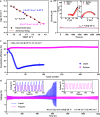Tailoring polymer electrolyte ionic conductivity for production of low- temperature operating quasi-all-solid-state lithium metal batteries
- PMID: 36717554
- PMCID: PMC9886912
- DOI: 10.1038/s41467-023-35857-x
Tailoring polymer electrolyte ionic conductivity for production of low- temperature operating quasi-all-solid-state lithium metal batteries
Abstract
The stable operation of lithium-based batteries at low temperatures is critical for applications in cold climates. However, low-temperature operations are plagued by insufficient dynamics in the bulk of the electrolyte and at electrode|electrolyte interfaces. Here, we report a quasi-solid-state polymer electrolyte with an ionic conductivity of 2.2 × 10-4 S cm-1 at -20 °C. The electrolyte is prepared via in situ polymerization using a 1,3,5-trioxane-based precursor. The polymer-based electrolyte enables a dual-layered solid electrolyte interphase formation on the Li metal electrode and stabilizes the LiNi0.8Co0.1Mn0.1O2-based positive electrode, thus improving interfacial charge-transfer at low temperatures. Consequently, the growth of dendrites at the lithium metal electrode is hindered, thus enabling stable Li||LiNi0.8Co0.1Mn0.1O2 coin and pouch cell operation even at -30 °C. In particular, we report a Li||LiNi0.8Co0.1Mn0.1O2 coin cell cycled at -20 °C and 20 mA g-1 capable of retaining more than 75% (i.e., around 151 mAh g-1) of its first discharge capacity cycle at 30 °C and same specific current.
© 2023. The Author(s).
Conflict of interest statement
The authors declare no competing interests.
Figures







References
-
- Zhou D, Shanmukaraj D, Tkacheva A, Armand M, Wang G. Polymer electrolytes for lithium-based batteries: advances and prospects. Chemistry. 2019;5:2326–2352.
-
- Zhou W, et al. Double-layer polymer electrolyte for high-voltage all-solid-state rechargeable batteries. Adv. Mater. 2019;31:1805574. - PubMed
-
- Yoon M, et al. Reactive boride infusion stabilizes Ni-rich cathodes for lithium-ion batteries. Nat. Energy. 2021;6:362–371.
-
- Han B, et al. 500 Wh kg(-1) class Li metal battery enabled by a self-organized core-shell composite anode. Adv. Mater. 2020;32:2004793. - PubMed
Grants and funding
LinkOut - more resources
Full Text Sources
Other Literature Sources

